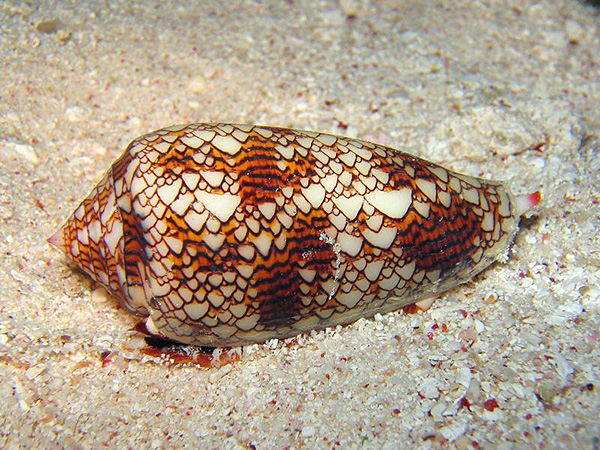Textile Cone Snail
Conus textile
Cone snails are one of the most venomous creatures on earth. Among the most toxic are the textile, geographic, and tulip snails and there is a higher risk of death if the geographic and textile snails are involved. All capture their prey by means of harpoon-like hollow teeth (radula) that are rapidly jabbed into their prey to inject the toxic venom. Attacks on humans usually occur when a cone snail is either stepped on in the ocean or picked up from the water or the beach.

Credit: Courtesy of NSF
SPECIES IN DETAIL
Textile Cone Snail
Conus textile
CONSERVATION STATUS: Vulnerable
CLIMATE CHANGE: Not Applicable
At the Aquarium
This species is not currently on exhibit at the Aquarium.
Geographic Distribution
Throughout the Indo-Pacific region, Australia, and the Indian Ocean from eastern Africa to Hawaii and French Polynesia.
Habitat
The textile cone lives in the sand beneath coral and rocks in shallow waters.
Physical Characteristics
This marine cone snail has a highly glossy, heavy shell and a short spine with straight or slightly concave sides. The body whorl is convex with rounded or slightly angled shoulders. There are slight spiral ridges near the base of the shell, and the rest is smooth.
The color and pattern of this beautiful cone is highly variable. The background color is some variation of white or bluish white, with light to dark brown or yellowish overlapping textile markings, and three yellowish or brown interrupted spiral bands.
Size
The average length of these animals is 9.0 cm (3.5 in).
Diet
This cone is a molluscivore, a mollusk eater. It is known to be cannibalistic if other food is scarce.
Reproduction
The textile cone’s egg capsules contain 500-700 eggs each The capsules are laid under rocks. Very few survive. The few eggs that survive to hatch do so in about 16 to 17 days. The larvae remain pelagic for about 16 days, then settle onto substrate. At this time they are about 1.5 mm (0.06 in) in length.
Behavior
Follow this link to additional information about cone snails.
Special Notes
The venom of the textile shell is very toxic and the sting is known to have caused human fatalities.
SPECIES IN DETAIL | Print full entry
Textile Cone Snail
Conus textile
CONSERVATION STATUS: Vulnerable
CLIMATE CHANGE: Not Applicable
This species is not currently on exhibit at the Aquarium.
Throughout the Indo-Pacific region, Australia, and the Indian Ocean from eastern Africa to Hawaii and French Polynesia.
The textile cone lives in the sand beneath coral and rocks in shallow waters.
This marine cone snail has a highly glossy, heavy shell and a short spine with straight or slightly concave sides. The body whorl is convex with rounded or slightly angled shoulders. There are slight spiral ridges near the base of the shell, and the rest is smooth.
The color and pattern of this beautiful cone is highly variable. The background color is some variation of white or bluish white, with light to dark brown or yellowish overlapping textile markings, and three yellowish or brown interrupted spiral bands.
The average length of these animals is 9.0 cm (3.5 in).
This cone is a molluscivore, a mollusk eater. It is known to be cannibalistic if other food is scarce.
The textile cone’s egg capsules contain 500-700 eggs each The capsules are laid under rocks. Very few survive. The few eggs that survive to hatch do so in about 16 to 17 days. The larvae remain pelagic for about 16 days, then settle onto substrate. At this time they are about 1.5 mm (0.06 in) in length.
The venom of the textile shell is very toxic and the sting is known to have caused human fatalities.

